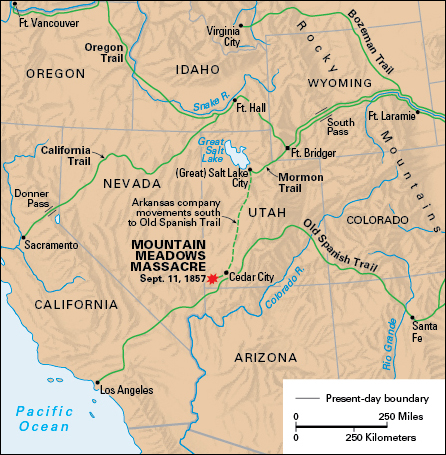Mountain Meadows Massacre was one of the most controversial massacres in United States history. On Sept. 11, 1857, Mormon settlers in southern Utah Territory, joined by some Native American warriors they had recruited, attacked and killed about 120 members of a wagon train on its way to the state of California on the Pacific coast of the United States. “Mormons” is the name commonly given to members of The Church of Jesus Christ of Latter-day Saints. They settled in Utah beginning in 1847.

The massacre occurred during the Utah War (1857-1858), in which the U.S. government sent members of the Army to Utah to put down a reported Mormon rebellion. Anticipating an invasion by U.S. troops, Mormon leader and Utah Territorial Governor Brigham Young declared martial law in the territory. Martial law is a temporary, emergency form of government under military rule. Young also told his people to stop trading with wagon trains passing through Utah, in order to maintain the Mormons’ food supplies. The wagon trains depended on supplies they got in Utah to sustain them all the way to California.
Around April 1857, Alexander Fancher and John Baker led wagon trains westward from the state of Arkansas . This group of emigrants, called the Arkansas company, was unaware of the conflict developing between the U.S. government and the Mormons. They arrived in Great Salt Lake City (now Salt Lake City ) in early August 1857, then continued south toward California. A series of minor confrontations with Mormon settlers occurred as the Arkansas company traveled through Utah. Some Mormons might have been offended by what they perceived as insulting behavior by the emigrants. They also might have believed false rumors that the emigrants were poisoning local wells and cattle. As the company passed through southern Utah, local Mormon leaders Isaac Haight and John D. Lee saw a chance to seize the travelers’ supplies, and so devised a plan to attack them. They hoped to blame the attack on their Native American Paiute allies.
Lee led Paiutes and Mormons disguised as Indians in the initial attack on the wagon train near Cedar City, Utah, on Sept. 7, 1857. What began as a surprise ambush turned into a week-long siege. Lee needed reinforcements to overcome the travelers’ well-fortified wagons. Only William Dame, commander of the territorial militia in southern Utah, could authorize such reinforcements. A council of local leaders sent an express rider to Great Salt Lake City to ask Brigham Young’s advice. Before Young’s reply came, Dame authorized the militia to overwhelm the Arkansas company.
On Sept. 11, 1857, under a white flag of truce, Lee met with the emigrants. He told them the militia would accompany them to safety. Then the militia, the remaining Paiutes, and Mormons disguised as Paiutes attacked the unarmed emigrants. They slaughtered about 120 men, women, and children. They spared only 17 children who were considered too young to testify against their attackers. The militia took the emigrants’ property, distributed a small amount to the Paiutes, and returned to their settlements. They found foster homes for the child survivors, who eventually rejoined their families in the East. After returning to Cedar City, Haight received a reply from Brigham Young, who instructed him to leave the emigrants alone. The message had arrived too late.
The U.S. government conducted multiple investigations into the massacre, but only Lee was convicted for his involvement in it. The federal government executed Lee on March 23, 1877. The role of Mormon leaders in the massacre and the cover-up that followed has remained a controversial topic. Most scholars now believe that the massacre was authorized by a handful of local authorities in whom too much power was concentrated and who were misled by rumors and driven by greed and mistrust. They also generally agree on Brigham Young’s involvement in the cover-up. Others think that Brigham Young ordered or supported the massacre.
